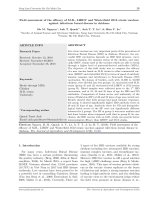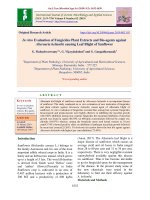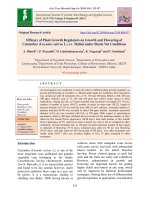Efficacy of some fungicides and bio-control agents against tuber rot (Fusarium oxysporum) of Kalazeera (Bunium persicum)
Bạn đang xem bản rút gọn của tài liệu. Xem và tải ngay bản đầy đủ của tài liệu tại đây (154.1 KB, 6 trang )
Int.J.Curr.Microbiol.App.Sci (2018) 7(7): 3752-3757
International Journal of Current Microbiology and Applied Sciences
ISSN: 2319-7706 Volume 7 Number 07 (2018)
Journal homepage:
Original Research Article
/>
Efficacy of Some Fungicides and Bio-control Agents against Tuber Rot
(Fusarium oxysporum) of Kalazeera (Bunium persicum)
Sabiya Bashir*, Mohammad Najeeb Mughal, Seeratun Nissa, Zahoor A. Dar, S.A.
Hakeem, Shabeena Majeed, Shaheena Nagoo and Sabeena Naseer
Sher-i-Kashmir University of Agricultural Sciences and Technology of Kashmir, Shalimar,
Srinagar-190025, India
*Corresponding author
ABSTRACT
Keywords
Bio-control, Kala
zeera, Fusarium
oxysporum, In-vitro,
Non- systemic
fungicides,
Systemic fungicides
Article Info
Accepted:
26 June 2018
Available Online:
10 July 2018
Six non-systemic fungicides viz., captan 50 WP, copper oxychloride 50 WP, dodine 65
WP, mancozeb75 WP, propineb 70 WP and zineb 80 WP and five systemic fungicides viz.,
bitertanol 25 WP, carbendazim 50 WP, difenconozole 25 EC, hexaconozole 5EC, and
myclobutanil 10 WP were evaluated against tuber rot of kalazeera caused by Fusarium
solani. The in-vitro evaluation of non-systemic fungicides through poisoned food
technique at five different concentrations viz., 50, 100, 250, 500 and 1000 ppm on active
ingredient basis (a.i) indicated that dodine was most effective exhibiting mean mycelial
growth inhibition of 82.27 per cent followed by captan (67.99%). Copper oxychloride
proved least effective and resulted in only 29.81 per cent mean inhibition of mycelial
growth. Among the systemic fungicides, evaluated at concentrations viz., 25, 50, 100, 200
and 500ppm on active ingredient basis (a.i), carbendazim proved most effective exhibiting
mean mycelial growth inhibition of 90.23 per cent followed by hexaconozole and
bitertanol with 71.24 and 64.56 per cent mean mycelial growth inhibition, respectively.
Myclobutanil proved least effective and resulted in only 52.76 per cent mean inhibition of
mycelial growth. Five strains of Trichoderma viride strains designated as Tv-1, Tv-2 Tv-3,
Tv-4, Tv-5 and two strain of Trichoderma harzianum designated as Th-1 and Th-2 were
also evaluated against tuber rot pathogen. Among the bio-control agents Tv-4 was most
efficacious and resulted in 48.20 mean mycelial growth inhibition followed by Tv-2 with
47.06 per cent mean inhibition of mycelial growth. Trichodermaviride-5 (Tv-5) proved
least efficious and resulted in only 26.40 per cent mean inhibition of mean mycelial
growth.
Introduction
Kala zeera (Bunium persicum) also black
cumin is an economically important culinary
crop that is cultivated for its seed pods and its
tuber like roots. In India, kalazeera is
cultivated in high altitude regions of Himachal
Pradesh and Jammu and Kashmir. In Jammu
and Kashmir, Kala zeera is confined to hilly
traits of Gurez, Machill, Tangdar, Pulwama,
Paddar, Karnah, Karewas of Budgam and
Srinagar. As per the Department of forest
estimates for year 1996- 97, Kala zeera
occupied about 225 hectares of forestland.
3752
Int.J.Curr.Microbiol.App.Sci (2018) 7(7): 3752-3757
Since the crop usually grows wild in scattered
pockets, the yields are lower at 129 kg/ha
(J&K) and 179 kg/ha (H.P), as compared to
350-400 kg/ha in the case of caraway (Panwar,
1992). The Yield of kalazeera is dwindling
year after year due to the diseases, insect pest,
inadequate planting density, high weeds
incidence lack of nutritional processing
techniques and poor crop management
practices (Anonymous 2004). Kala zeera is
prone to the number of diseases, including
both fungal and bacterial. Under temperate
conditions of Kashmir kalazeera is attacked by
Alternaria leaf spot and Cercospora leaf spot
pathogens but tuber rot caused by Fusarium
oxysporum is most important disease of
kalazeera which causes drying of foliage and
rotting of tubers. White fungal mycelia can be
observed on the tubers at the late stages of
disease development. Incidence of this disease
has been reported to vary from 80 to 90 per
cent and yield loss of 50 to 60 per cent has
been reported (Badri et al., 2013). The use of
fungicides and biological methods are most
effective andreliable methods of controlling
the disease. Fungicides with novel chemistry
are being introduced and evaluated before
their application can be recommended to
farmers. Therefore, laboratory evaluation of
the fungicides is of paramount importance.
There is constant need to watch and evaluate
new fungicides along with some non-chemical
method of controlling the wilt disease (Patel,
1998). Therefore, present studies were carried
out to evaluate non- systemic and systemic
fungicides and some bio-control agents
against the disease and the results are
presented herein.
difenconazole 25EC, hexaconozole 5EC, and
myclobutanil 10WP were evaluated in-vitro
on active ingredient (a.i) basis against tuber
rot of kalazeera caused by Fusarium solanit
hrough poisoned food technique (Carpenter,
1942) using potato dextrose agar medium. The
non-systemic fungicides were evaluated at 50,
100, 250, 500 and 1000 ppm and systemic
fungicides at 50, 100, 200, 400 and 500 ppm.
The required concentrations of fungicides
were prepared by adding appropriate amount
of fungicides to sterilized molten PDA
medium in conical flasks. Thirty millilitre of
such amended PDA was aseptically poured in
sterilized Petri plates. A 5 mm diameter
mycelial disc of FOC was aseptically placed
in the centre of each Petri plate. Petri plates
containing PDA media amended with equal
amount of sterilized distilled water and
inoculated with mycelial disc of Fusarium
oxysporum (5 mm diameter) served as check.
Each treatment was replicated thrice and
incubated at 28±2oC for 48 hrs. The
comparative efficacy of fungicides was
calculated as per cent inhibition of mycelial
growth of the test fungus in each treatment as
compared to check by the following formula:
Materials and Methods
In-vitro evaluation of bio-control agents
Sixnon-systemic fungicides viz., captan
50WP, copper oxychloride 50 WP, dodine 65
WP, mancozeb 75 WP, propineb 70WP and
zineb 80WP and five systemic fungicides viz.,
bitertanol 25WP, carbendazim 50 WP,
The biological control agents were isolated
from soils of different parts of Kashmir and
designated as Trichoderma viridi 1,
Trichoderma viridi 2, Trichoderma viridi 3,
Trichoderma viridi 4 and Trichoderma viridi
Per cent mycelial growth inhibition =
C – T × 100
C
Where
C = Radial mycelial growth (mm) in check
T = Radial mycelial growth in the treatment
(mm)
3753
Int.J.Curr.Microbiol.App.Sci (2018) 7(7): 3752-3757
5, and Trichoderma harzianum 1 and
Trichoderma harzianum 2. The pure culture
was multiplied in the test tubes slants. Agar
slants of these cultures were placed in
refrigerator at 40C. Mycelial discs (5mm
diameter)of bio-control agent and the
pathogen were simultaneously inoculated at
the opposite ends of the Petriplates, containing
about 20 ml of PDA medium. Three Petri
plates were used for each biological control
agent and the same number was kept as
control. Inoculated Petri plates were incubated
at 25±2oC for 7-10 days. The data regarding
per cent inhibition of mycelial growth were
calculated by standard method.
Results and Discussion
Persual of data (Table 1) indicate that among
non-systemic fungicides, dodine was most
effective exhibiting highest mean mycelial
growth inhibition of 82.27per cent followed
by captan (67.92%)while mancozeb, zineb and
antracol resulted in mean inhibition of
mycelial growth of 58.98, 46.86 and 46.14 per
cent, respectively. Copper oxychloride proved
least effective among non-systemic fungicides
and resulted in lowest mean mycelial
inhibition of 29.81per cent only. In general,
the efficacy of fungicides increased with
increase in their concentrations. At the lowest
concentration of 50 ppm, dodine was most
effective causing 61.66 per cent mean
mycelial inhibition followed by captan (44.40)
while copper oxychloride was least efficacious
(25.90%). Similar trend was observed with
increase in concentration and at the highest
concentration (1000 ppm) dodine completely
inhibited the mycelial growth of the pathogen
followed by captan which caused 81.43 per
cent mean mycelial inhibition and copper
oxychloride resulted in lowest mean mycelial
inhibition of only 38.20 per cent.
Among the five systemic fungicides (Table 2),
carbendazim proved most effective exhibiting
highest mean mycelial growth inhibition of
90.23per cent followed by hexaconozole and
bitertanol with 71.24 and 64.56 per cent mean
mycelial growth inhibition, respectively.
Difenoconazole resulted in mean mycelia
growth inhibition of 60.84per cent, while
myclobutanil proved least effective among the
systemic fungicides and resulted in lowest
mean mycelial growth inhibition of only
52.76per cent mean.
In general, the efficacy of fungicides increased
with increase in their concentrations. At the
lowest concentration of 50 ppm, carbendazim
was most effective causing 82.00 per cent
mean mycelial inhibition followed by
hexaconazole (53.80%) while myclobutanil
was least efficacious (43.53%).
Similar trend was observed with increase in
concentration of fungicides and efficiency of
fungicides increased with increase in their
concentrations. Carbendazim resulted in100
per cent inhibition at 200 and 500 ppm
concentrations. However, no other fungicide
could cause complete inhibition of mycelial
growth of the pathogen at 200 ppm
concentration. At the highest concentration
(500 ppm) hexaconazole also completely
inhibited the mycelial growth (100% mycelial
growth inhibition) of the pathogen followed
by difenoconazole and bitertenol which
caused 74.30 and 66.70 per cent mean
mycelial inhibition, respectively. Even at the
highest concentration (500ppm), myclobutanil
resulted in lowest mean mycelial growth
inhibition of only61.50 per cent.
The in-vitro evaluation of bio-control agents
revealed that Tv-4 and Tv-2 was most
efficacious and resulted in 48.20 and 47.06 per
cent mean mycelial inhibition followed by Tv1 with 45.93 per cent mean inhibition of
mycelial growth. Trichoderma viride-5 (Tv-5)
proved least efficious and resulted in only
26.40 per cent mean inhibition of mycelial
growth (Table 3).
3754
Int.J.Curr.Microbiol.App.Sci (2018) 7(7): 3752-3757
Table.1 In-vitro evaluation of non-systemic fungicides against Fusarium oxysporum causing
tuber rot of kalazeera
Fungicides
Per cent inhibition of radial mycelial growth at concentration (ppm)
50
100
250
500
1000
Mean
Captan 50WP
44.40
70.06
71.86
72.20
81.43
67.99
(41.77)
(56.84)
(57.98)
(58.20)
(64.48)
Mancozeb 75 WP
44.03
53.26
53.26
64.16
80.20
58.98
(41.03)
(46.87)
(46.87)
(53.23)
(63.62)
Copper oxychloride 50 25.90
28.33
27.06
29.56
38.20
29.81
WP
(30.59)
(32.11)
(31.26)
(32.93)
(38.17)
Antracol 70 WP
37.00
38.23
41.96
50.60
62.90
46.14
(37.46)
(38.23)
(40.37)
(45.34)
(52.51)
Dodine 65WP
61.66
75.33
81.43
92.96
100.00
82.27
(51.75)
(60.17)
(64.48)
(74.67)
(90.00)
Zineb
35.76
43.13
43.16
51.83
60.43
46.86
(36.76)
(41.05)
(41.06)
(46.04)
(51.02)
Mean
41.45
51.18
53.12
60.22
70.52
CD (P=0.05)
Non-systemic fungicide
= (2.1)
Concentration
= (1.9)
Fungicide × Concentration
= (4.70)
*Figures within parentheses are arc sign transformed values
Table.2 In-vitro evaluation of systemic fungicides against Fusarium oxysporum causing tuber rot
of kalazeera
Fungicides
Hexaconozole
5EC
Myclobutanil
10 WP
Carbendazim
50WP
Difenconazole
25 EC
Bitertanol
25WP
Mean
Per cent inhibition of radial mycelial growth at concentration
25
50
100
200
500
53.80 (41.17)
61.50
66.60
74.30
100.00
(51.64)
(54.69)
(59.53)
(90.00)
43.53 (41.28)
51.23
51.20
56.33
61.50
(45.70)
(45.68)
(48.63)
(51.64)
82.00 (64.89)
84.56
84.60
100.00
100.00
(66.86)
(66.89)
(90.00)
(90.00)
51.23 (45.70)
64.03
64.06
69.16
74.30
(53.14)
(53.16)
(56.26)
(59.53)
48.66 (44.23)
56.33
64.10
66.63
66.70
(48.63)
(53.19)
(54.71)
(54.74)
55.84
63.53
66. 11
73.28
80.50
CD (P=0.05)
Fungicide
= (1.27)
Concentration
= (125)
Fungicide × Concentration
= (2.33)
Figures within parentheses are arc sign transformed values
3755
(µg ml-1)
Mean
71.24
52.76
90.23
60.84
64.56
Int.J.Curr.Microbiol.App.Sci (2018) 7(7): 3752-3757
Table.3 In-vitro evaluation of bio-control agents against Fusarium oxysporum causing tuber rot
of Kala zeera
Bio-control agents
Per cent inhibition in radial mycelial growth
of the pathogen
45.93
(42.66)
47.06
(43.31)
37.70
(34.87)
48.20
(43.96)
26.40
(30.87)
36.73
(37.30)
39.60
(38.99)
Trichoderma viridi-1
(Tv-1)
Trichoderma viridi-2
(Tv-2)
Trichoderma viridi-3
(Tv-3)
Trichoderma viridi-4
(Tv-4)
Trichoderma viridi-5
(Tv-5)
Trichoderma harzianum-1
(Th-1)
Trichoderma harzianum -2
(Th-2)
CD (P=0.05)
(2.01)
Figures within parentheses are arc sign transformed values
Evaluation of fungicides and bio-control
agents in-vitro is indispensible for
determining their efficacies before they are
finally take to field for evaluation. In-vitro
evaluation helps in selecting the best
fungicide(s) and bio-control agent(s) among
the array of fungicides and bio-control agents.
In-vitro evaluation also determines the best
concentration at which the fungicide(s) is/are
most effective. Evaluation of fungicides in
field without in-vitro evaluation at different
concentrations is practically not feasible and
would include huge land, labour and costs.
Kala zeera is a niche crop of Kashmir and not
much work has been done on diseases of this
important cash crop. Our results are in
conformity with those reported by Aghnoom
et al, (1999), Aghnoom et al., (2002),
Ghasolia and Jain (2004), Khan et al., (2012).
Generally, all the treatments checked the
activities of the pathogen (Fusarium
oxysporum) and consequently promote the
growth of Kala zeera. In the present study,
among biological control agents, Trichoderma
viridi proved most effective and these
findings were completely in agreement with
Saikia et al., 2003; Ghasolia and Jain, 2004
and Postma et al., 2003.
References
Aghnoom,
R.,
M.
Falahati-Rastegar,
Jafarpour,B. 1999.Comparison of
chemical and biological control of
cumin wilt (Fusarium oxysporum f.
sp. cumini) in laboratory and green
house conditions. Iranian Journal of
Agricultural Science 30(3), 619-630.
Aghnoom, R., M. Falahati-Rastegar, B.
Jafarpour, 2002, Comparison of
chemical and biological control of
cumin wilt (Fusarium oxysporum f.
sp. cumini) in laboratory and green
house conditions. Iranian Journal of
Agricultural Sciences. 30(3): 619-630.
3756
Int.J.Curr.Microbiol.App.Sci (2018) 7(7): 3752-3757
Anonymous. 2004.Progress report of NATP
subproject on selection of improved
genotypes and development of
sustainable production systems for
kalazeera (B. persicum Bioss.).
SKUAST-K p. 49.
Badri, Z. A.,Rather, M. A., Parmeet
Singh.2013.Evaluation
of
fungitoxicants
against Fusariumsolanicausing tuber
rot disease of kalazeera [Bunium
persicum(
Bioss)
Fedtsch.].
Environment and Ecology 31(4):
1851-1855.
Carpenter, J.B., 1942.A toximetric study of
some
eradicant
fungicides.
Phytopathology 32: 845.
Ghasolia, R. P., S. C. Jain, 2004, Evaluation
of fungicides, bio-agents, phytoextracts and physical seed treatment
against Fusarium oxysporum f. sp.
Cumini causing wilt in cumin. Journal
of Mycology Plant Pathology. 34(2):
334-336.
Khan, H.S.I., M. Saifulla, A.S.N. Nawaz, P.R.
Somashekharappa and R. Razvi. 2012.
Efficacy of fungicides and bio-control
agents against Fusarium oxysporum f.
sp. ciceris causing wilt of chickpea.
Journal of Environment and Ecology
3: 570-572.
Panwar K. Kala zeera: A low volume, high
price crop for dry temperate hills. Ind
Farmers Digest 25(11): 21-23, 1992
Patel, S. M., B. K. Patel. 1998. Inhibitory
effect of different fungal bio-agents on
Fusarium oxysporum f. sp. Cumini
causing cumin wilt. Annals of Plant
Protection Science 6(1): 25-27.
Postma, J., M. Montanari and J. F. Van den
Boogert (2003). Microbial enrichment
to enhance disease suppressive
activity of compost. European Journal
of Soil Biology. 39:157-163.
How to cite this article:
Sabiya Bashir, Mohammad Najeeb Mughal, Seeratun Nissa, Zahoor A. Dar, S.A. Hakeem,
Shabeena Majeed, Shaheena Nagoo and Sabeena Naseer. 2018. Efficacy of Some Fungicides
and Bio-control Agents against Tuber Rot (Fusarium oxysporum) of Kalazeera (Bunium
persicum). Int.J.Curr.Microbiol.App.Sci. 7(07): 3752-3757.
doi: />
3757









